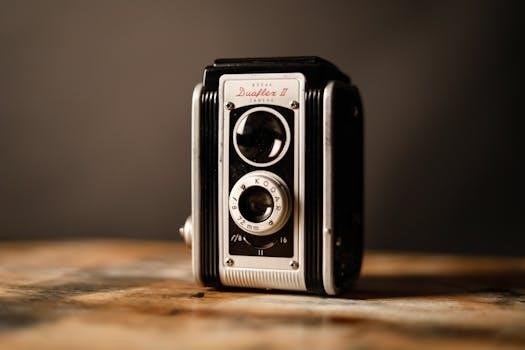
-
By:
- ophelia
- No comment
sennheiser rs 120 ii manual
Sennheiser RS 120 II Manual⁚ A Comprehensive Guide
Welcome to the ultimate resource for your Sennheiser RS 120 II wireless headphone system! This guide provides clear instructions, helpful tips, and troubleshooting for optimal performance and longevity. Discover everything from setup to maintenance, ensuring a seamless and enjoyable listening experience.
The Sennheiser RS 120 II is a popular wireless headphone system designed for comfortable and convenient home audio listening. As an updated version of the classic RS 120, the RS 120 II offers improved features and performance for an enhanced user experience. This system allows you freedom of movement while enjoying your favorite TV shows, music, or podcasts without disturbing others.
The RS 120 II is known for its ease of use and reliable wireless connection. It uses an open, supra-aural design that provides a natural and airy sound experience. Weighing only 230g, these headphones are lightweight and comfortable for extended listening sessions. The system includes the headphones (HDR 120 II) and a transmitter (TR 120 II) that also serves as a charging dock.
This comprehensive guide will walk you through every aspect of the Sennheiser RS 120 II, from initial setup and operation to troubleshooting common issues and maintaining your device. Whether you are a new owner or a long-time user, this manual will provide valuable insights to maximize your enjoyment of the RS 120 II.
Key Features and Specifications
The Sennheiser RS 120 II boasts several key features that make it a standout wireless headphone system. Its open, supra-aural design provides a natural and spacious soundstage, enhancing the listening experience. The wireless connectivity offers freedom of movement, allowing you to enjoy audio without being tethered to a cable. The transmitter unit not only sends the audio signal but also serves as a convenient charging station for the headphones.
Here are some essential specifications to consider. The headphones have a sensitivity of 106 dB, ensuring clear and detailed sound reproduction. The system operates on the RF frequency band, providing a reliable wireless range. The headphones are lightweight, weighing approximately 230 grams, which contributes to comfortable extended use. The transmitter includes an audio connection cable and an adapter for compatibility with various audio sources.
The RS 120 II utilizes rechargeable NiMH batteries (AAA, 1.2V). These batteries provide ample listening time when fully charged. The transmitter features automatic on/off functionality and trickle charging, ensuring the headphones are always ready for use. These features combine to deliver a user-friendly and high-quality wireless audio solution.
Setting Up Your RS 120 II
Setting up your Sennheiser RS 120 II is a straightforward process. First, unpack all the components, including the headphones, transmitter, power supply, and audio cable. Ensure all parts are present and undamaged. Next, insert the rechargeable NiMH batteries into the headphones, paying attention to the correct polarity. The battery compartment is usually located under the earcup padding. Secure the battery cover properly.
Position the transmitter in a central location, free from obstructions that may interfere with the wireless signal. Connect the power supply to the transmitter and plug it into a power outlet. The transmitter’s LED indicator should light up, indicating that it’s receiving power. Now, connect the audio cable from the transmitter to your audio source, such as a TV, stereo system, or computer. You may need to use the provided adapter depending on your audio source’s output jack.
Place the headphones on the transmitter’s charging cradle to begin charging the batteries. Allow the headphones to charge fully before initial use. The LED indicator on the transmitter will typically flash during charging and remain solid once the charging is complete. Once charged, your RS 120 II is ready to deliver wireless audio enjoyment.

Connecting the Transmitter
Connecting the Sennheiser RS 120 II transmitter correctly is crucial for optimal audio transmission. Begin by identifying the appropriate audio output on your source device, such as a TV, stereo, or computer. Look for a headphone jack (3.5mm) or RCA audio outputs (red and white). If your device has a 6.3mm headphone jack, use the provided adapter.
Once you’ve located the correct output, use the included audio cable to connect it to the audio input on the rear of the RS 120 II transmitter. Ensure the connection is secure to prevent signal loss or distortion. If you’re using RCA outputs, plug the red and white connectors into the corresponding jacks on both the source device and the transmitter.
After establishing the audio connection, plug the power adapter into the transmitter and then into a wall outlet. Confirm that the transmitter’s power LED illuminates, indicating it’s receiving power. Make sure the transmitter is placed in an open area, away from metal objects or other electronic devices that might interfere with the wireless signal. A clear line of sight between the transmitter and headphones is generally best for optimal performance. With these connections secured, your RS 120 II system is nearly ready to deliver high-quality wireless audio.
Charging the Headphones
Ensuring your Sennheiser RS 120 II headphones are properly charged is essential for uninterrupted listening pleasure. The charging process is straightforward, utilizing the transmitter as a charging dock. First, make sure the two AAA NiMH rechargeable batteries are correctly inserted into the headphone’s battery compartment, paying attention to the polarity (+ and -) markings.
To charge the headphones, gently place them onto the transmitter unit, ensuring that the charging contacts on the headphones align with the charging pins on the transmitter base. You should see the charging indicator LED on the transmitter illuminate, signifying that the charging process has begun. Typically, a full charge takes around 16 hours for completely depleted batteries.
During charging, the LED may flash, indicating the charging status. Once the batteries are fully charged, the LED will either remain solid or change color, depending on the specific model. The transmitter is designed with a trickle-charge feature, preventing overcharging and maintaining optimal battery health even if the headphones remain on the base after they are fully charged. For best results, always allow the headphones to fully charge before their first use and avoid interrupting the charging cycle unnecessarily. Regularly charging your RS 120 II headphones will ensure they are always ready for your next listening session.
Operating the RS 120 II
Operating the Sennheiser RS 120 II headphones is designed to be intuitive and user-friendly. After ensuring the transmitter is properly connected to your audio source and the headphones are charged, you’re ready to begin. The primary controls are located directly on the headphones themselves, allowing for easy adjustments without needing to interact with the transmitter.
To power on the headphones, locate the power switch, usually found on one of the earcups. Slide the switch to the “on” position. You should hear a faint static or hiss, indicating that the headphones are active and searching for the transmitter’s signal. Once a connection is established, the static will disappear, and you’ll hear the audio from your source;
Adjusting the volume is also straightforward, using the volume control dial located on one of the earcups. Rotate the dial to increase or decrease the sound level to your desired preference. If you experience interference or a weak signal, you may need to adjust the frequency tuning on both the headphones and the transmitter to find a clear channel. Remember to power off the headphones when not in use to conserve battery life. Enjoy your wireless listening experience!
Powering On/Off and Volume Control
The Sennheiser RS 120 II offers simple and convenient controls for powering the headphones on and off, as well as adjusting the volume to your preferred listening level. These controls are typically located on the right earcup for easy access during use.

To power on the RS 120 II headphones, locate the power switch, usually a sliding switch. Slide this switch to the “ON” position. You might hear a slight static sound as the headphones attempt to connect with the transmitter. Once a stable connection is established, the static should disappear, and you’ll hear the audio from your connected source.
To power off the headphones, simply slide the same switch to the “OFF” position. This will disconnect the headphones from the transmitter and conserve battery power. For volume control, the RS 120 II features a rotating dial, also located on the earcup. Rotate the dial clockwise to increase the volume and counter-clockwise to decrease it. Adjust the volume to a comfortable level, ensuring you don’t strain your hearing.
Remember to always power off the headphones when not in use to maximize battery life and prevent unnecessary drain.
Adjusting the Frequency
The Sennheiser RS 120 II operates on radio frequencies, and occasionally, you might experience interference from other electronic devices. To combat this, the RS 120 II provides options for adjusting the transmission frequency, ensuring a clear and uninterrupted audio signal.

Both the transmitter and the headphones have a channel selector switch, typically offering three different frequency channels. If you encounter static, distortion, or a weak signal, try switching the channel on both the transmitter and the headphones. It is crucial to match the channel on both devices for proper operation.
Start by selecting a different channel on the transmitter. Then, adjust the channel on the headphones to match the newly selected channel on the transmitter. It might take a few attempts to find the clearest channel with minimal interference. Experiment with different channel combinations until you achieve optimal audio quality.
Keep in mind that the best channel might vary depending on your environment and the presence of other electronic devices. If the issue persists, consider moving the transmitter away from potential sources of interference or trying a different location altogether. Properly adjusting the frequency can significantly improve your listening experience.
Troubleshooting Common Issues
Even with proper setup and usage, you might occasionally encounter issues with your Sennheiser RS 120 II. This section addresses common problems and offers troubleshooting steps to help you resolve them quickly and efficiently, ensuring minimal disruption to your listening enjoyment.
Before diving into specific issues, double-check the basics⁚ ensure the transmitter is properly connected to the audio source, the headphones are powered on, and the volume is at an audible level. Also, verify that the batteries are adequately charged, as low battery levels can lead to various performance problems.
If you’re experiencing difficulties, systematically work through potential causes. Consult the following sections for targeted solutions to specific problems like no sound, distorted audio, or charging problems. By identifying the root cause, you can implement the appropriate fix and restore your RS 120 II to optimal working condition.
Remember to consult the Sennheiser website or contact their customer support for further assistance if the suggested troubleshooting steps do not resolve your issues. They can offer expert guidance and support to address more complex technical challenges.
No Sound or Distorted Audio
Encountering silence or distorted audio with your Sennheiser RS 120 II can be frustrating. If you’re not hearing any sound, first ensure that both the transmitter and headphones are powered on. Verify that the audio source is playing and the volume is turned up. Check the connection between the transmitter and your audio device; a loose or incorrect connection can cause silence.
If there’s sound but it’s distorted, try adjusting the frequency on both the transmitter and headphones. Interference from other devices can sometimes cause distortion. Also, make sure the headphones are within the operating range of the transmitter. Obstacles like walls can weaken the signal.

Low battery levels in either the transmitter or headphones can also lead to distorted audio. Ensure both are adequately charged. If the problem persists, test with a different audio source to rule out issues with the original device. Faulty cables can also cause problems, so try using a different audio cable to connect the transmitter.
If none of these steps resolve the issue, the headphones or transmitter may require professional servicing. Contact Sennheiser support for further assistance.
Charging Problems
If you are experiencing difficulties charging your Sennheiser RS 120 II headphones, several factors could be at play. First, ensure that the headphones are correctly placed on the transmitter’s charging cradle. The charging contacts must align properly for charging to occur. Check that the transmitter is powered on and connected to a functioning power outlet; a faulty outlet or power adapter can prevent charging.
Examine the charging contacts on both the headphones and the transmitter for any dirt or debris. Clean them gently with a dry cloth to ensure a good connection. If the charging indicator light on the transmitter isn’t illuminating when the headphones are placed on the cradle, this could indicate a problem with the transmitter or the charging circuit.
Over time, rechargeable batteries degrade and lose their capacity to hold a charge. If your headphones are old, the batteries might need replacing. Consider purchasing new, compatible rechargeable batteries. If the problem persists after replacing the batteries, the issue may lie within the headphones’ internal charging circuitry or the transmitter itself.
Contact Sennheiser support for advanced troubleshooting or repair options if basic steps fail to resolve charging problems. They can provide expert guidance and potentially diagnose hardware failures.
Maintaining Your RS 120 II
Proper maintenance is essential for prolonging the life and performance of your Sennheiser RS 120 II headphones. Regular cleaning prevents the buildup of dust, earwax, and other debris that can affect sound quality and hygiene. Gently wipe the earcups and headband with a soft, dry cloth to remove surface dirt. For more stubborn residue, slightly dampen the cloth, ensuring no moisture enters the internal components.
When not in use, store your RS 120 II headphones in a clean, dry place, away from direct sunlight and extreme temperatures. Avoid wrapping the headphones’ cable too tightly, as this can damage the wires. If possible, store them in a headphone case or bag to protect them from dust and physical damage.
Periodically check the rechargeable batteries for signs of wear or damage. Replace them if they no longer hold a charge effectively. Consider removing the batteries if you plan to store the headphones for an extended period, as batteries can leak and cause corrosion. Inspect the audio cables for any fraying or damage, and replace them if necessary to maintain optimal audio signal transmission.
Following these simple maintenance steps will help keep your Sennheiser RS 120 II headphones in excellent condition, ensuring years of reliable and enjoyable use.
Cleaning and Storage
To ensure the longevity and optimal performance of your Sennheiser RS 120 II headphones, proper cleaning and storage are crucial. Regularly clean the headphones to remove dust, sweat, and earwax that can accumulate over time. Use a soft, dry cloth to gently wipe the earcups, headband, and transmitter. For stubborn dirt, slightly dampen the cloth with water, but avoid getting any moisture inside the devices.
Pay special attention to cleaning the earpads, as they come into direct contact with your skin. If the earpads are removable, detach them for easier cleaning. You can use a mild soap solution on a damp cloth to clean them, but make sure they are completely dry before reattaching them.
When not in use, store your RS 120 II headphones in a cool, dry place away from direct sunlight and extreme temperatures. Avoid storing them in humid environments, as moisture can damage the internal components. Ideally, store the headphones in their original packaging or a dedicated headphone case to protect them from dust, scratches, and accidental damage.
Ensure that the transmitter is also stored properly, away from liquids and potential hazards. By following these cleaning and storage guidelines, you can keep your Sennheiser RS 120 II headphones in excellent condition for years to come.